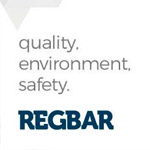Soil nailing is typically used to stabilize the slopes or excavations where the top/down structure is more advantageous in comparison with other retaining wall systems. In certain circumstances soil nailing is an applicable alternative in comparison with ground anchor walls used in commonly preferred top/down fixing system in terms of technical feasibility, construction costs and construction period.
On the Soil Nail
Superior Technology

What is a Soil Nail?
Regbar Soil Nails form additional reinforcements in top/down constructions and for stabilization of excavation and hillsides.

Types of Soil Nails
A wide range of products fully based on threaded rods available in 4 different categories and in 7 different diameters up to 65 mm.

Why Regbar?
As REGBAR family, we have vast knowledge and international experience in the fields of engineering and applications as of 2010.

Soil Nail Application
Soil nailing is a ground stabilisation technique that can be used on either natural or excavated slopes.

Increase Strength with Soil Nails
Regbar Soil Nails form additional reinforcements in top/down constructions and for stabilization of excavation and hillsides. Regbar Soil Nails are placed in the holes and ground anchorage is completed with shotcrete system. It is recommended that the soil nails should not exceed 60% of the final strength of the reinforcement.
• Tendons are suitable for temporary or permanent works as long as they don’t affect the adjacent buildings. (hangi komşular) They don’t need to be cut or taken off in the terrain and at a subsequent stage.
• A wide range of products fully based on threaded rods available in 4 different categories and in 7 different diameters up to 65 mm.
• High quality steel may be preferred for ease of transportation and to reduce the diameter of compressed hole.
• Corrosion prevention accessories are included in the system.
Highway excavation cross section
Expanding road under the end of an existing bridge.
Repairing and restructuring existing retaining structures.
Temporary or permanent excavations in urban areas.
It has been proven that soil nailing is economically attractive and technically applicable in below circumstances:
Excavated soil can stand without any support on 1-2 meter (3-6 ft) high vertical or almost vertical grounds for 1-2 days.
All soil nails in this section are above the groundwater table.
In order for soil nails to be corrosion resistant it is recommended that the reinforcements/rebars should be epoxy coated or galvanized. If needed, Regbar also provides coating service.
Regbar also designs and manufactures connection elements in conformity with special design and standards which are 100% compatible with Soil Nails.









Soil Nail Features
• Tendons are suitable for temporary or permanent works as long as they don’t affect the adjacent buildings. (hangi komşular) They don’t need to be cut or taken off in the terrain and at a subsequent stage.
• A wide range of products fully based on threaded rods available in 4 different categories and in 7 different diameters up to 65 mm.
• High quality steel may be preferred for ease of transportation and to reduce the diameter of compressed hole.
• Corrosion prevention accessories are included in the system. RESIM 1
Regbar Soil Nails form additional reinforcements in top/down constructions and for stabilization of excavation and hillsides. Regbar Soil Nails are placed in the holes and ground anchorage is completed with shotcrete system. It is recommended that the soil nails should not exceed 60% of the final strength of the reinforcement.
How is Soil Nails Applied?
Soil nailing is typically used to stabilize the slopes or excavations where the top/down structure is more advantageous in comparison with other retaining wall systems. In certain circumstances soil nailing is an applicable alternative in comparison with ground anchor walls used in commonly preferred top/down fixing system in terms of technical feasibility, construction costs and construction period.
Soil Nail walls are particularly suitable for excavations on vertical grounds or on grounds requiring vertical cuts and it has been shown that they are particularly suitable for the following temporary or permanent applications:
Highway excavation cross section
Expanding road under the end of an existing bridge.
Repairing and restructuring existing retaining structures.
Temporary or permanent excavations in urban areas.
It has been proven that soil nailing is economically attractive and technically applicable in below circumstances:
Excavated soil can stand without any support on 1-2 meter (3-6 ft) high vertical or almost vertical grounds for 1-2 days.
All soil nails in this section are above the groundwater table.
